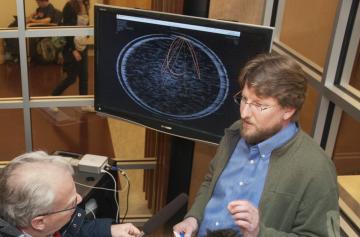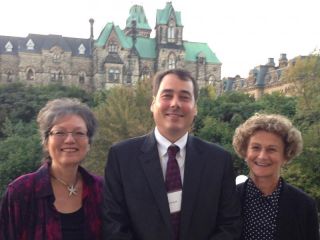Reading in the digital environment
- Patty Pitts

From ancient cave paintings to hand-printed books to Facebook, people have been reading in various forms for thousands of years. But what will the act of reading look like in the future and what can we learn from the past to ensure digital applications enhance and expand the reading experience?
Ray Siemens, Canada Research Chair in Humanities Computing, gave visiting federal officials a sneak peek at the future during a March 16 ceremony to announce nearly $2.5 million in funding through the Social Sciences and Humanities Research Council (SSHRC) Major Collaborative Research Initiative (MCRI) program for the "Implementing New Knowledge Environments" (INKE) project that Siemens is leading.
With Andrew Saxton, MP for North Vancouver and parliamentary secretary to the president of the Treasury Board, and Chad Gaffield, SSHRC president, looking on, Siemens demonstrated one of the tools his team will use as part of their project research.
A swirl of words appeared on a computer screen, representing the frequency and context of pre-selected words or phrases appearing in a designated work-in this case, a Shakespeare play. Siemens pointed out how the tool could help a graduate student conducting research on recurrent word use or themes in a body of work or a journalist wanting to quickly compare themes in US President Barack Obama's inaugural address to those of previous presidents.
"What we're specifically looking at is how to read better, how to communicate better, and how to write better," said Siemens. "We're looking at implementing new knowledge environments for the future."
The seven-year INKE project is assisted by an additional $10.4 million from institutional and research partners. Siemens and his international team of 35 researchers and 21 partner agencies will develop a better understanding of literacy in the digital age.
"We describe our work as 'the future of the history of the book,'" says Siemens. "We'll be looking at several thousands of years of societal interaction with book-like objects and examine through them how society mobilizes and interacts with knowledge. We'll be able to contribute directly to digital developments in this area."
The research team will focus their work in four areas. Textual studies, the evolution of reading and writing technologies from antiquity to present, will be led by Richard Cunningham at Acadia University and Alan Galey at the University of Toronto. User experience, or how and why people read and how the reading process can change the cognitive process, will be led by Teresa Dobson at the University of British Columbia and Claire Warwick at University College London. Interface design, how people visualize information on a computer, will be led by Stan Ruecker at the University of Alberta. Information management, or the building of new digital reading interfaces, will be led by Siemens and Susan Schreibman at the Royal Irish Academy. The research team will also involve 19 postdoctoral research fellows and 53 graduate research assistants from all participating institutions.
SSHRC MCRI funding will be supplemented with support from several partners including the Canadian Association of Research Libraries, the Canadian Research Knowledge Network, Service BC, Les Presses de l'Universit&e#180; de Montr&e#180;al, the Public Knowledge Project, and ProQuest-a digital database of historical documents and academic materials.
INKE will incorporate its technical, historical, psychological and sociological knowledge into functioning prototypical computational models which it will share online. "The best parts of research are when our research developments engage the reading public's interest and needs," says Siemens. "Our research area teams will work together at UVic as well as at their own institutions and elsewhere to apply humanities principles to a basic social technology issue-understanding all the reading devices we've used and what it might mean for the future."
A full list of researchers, participating institutions, and partners can be found at the project's website, www.inke.ca.
Photos
In this story
Keywords: reading, digital, environment



